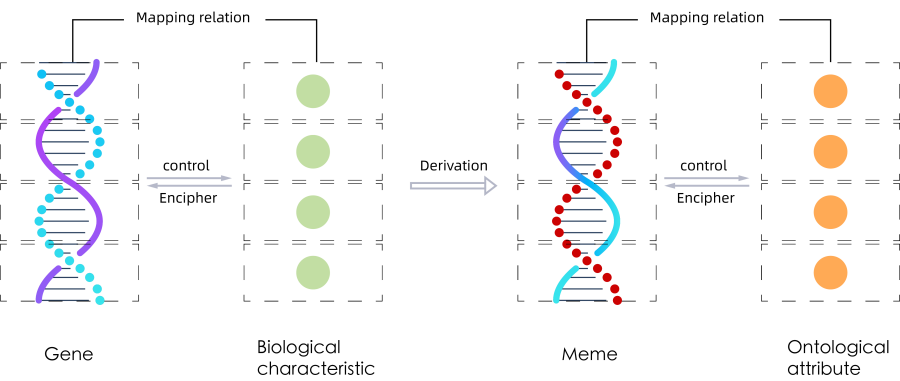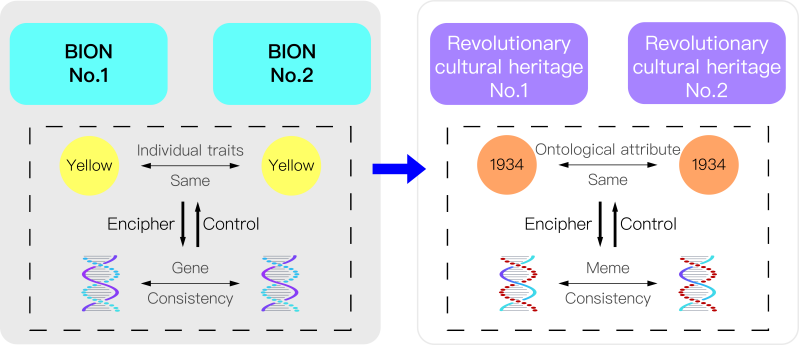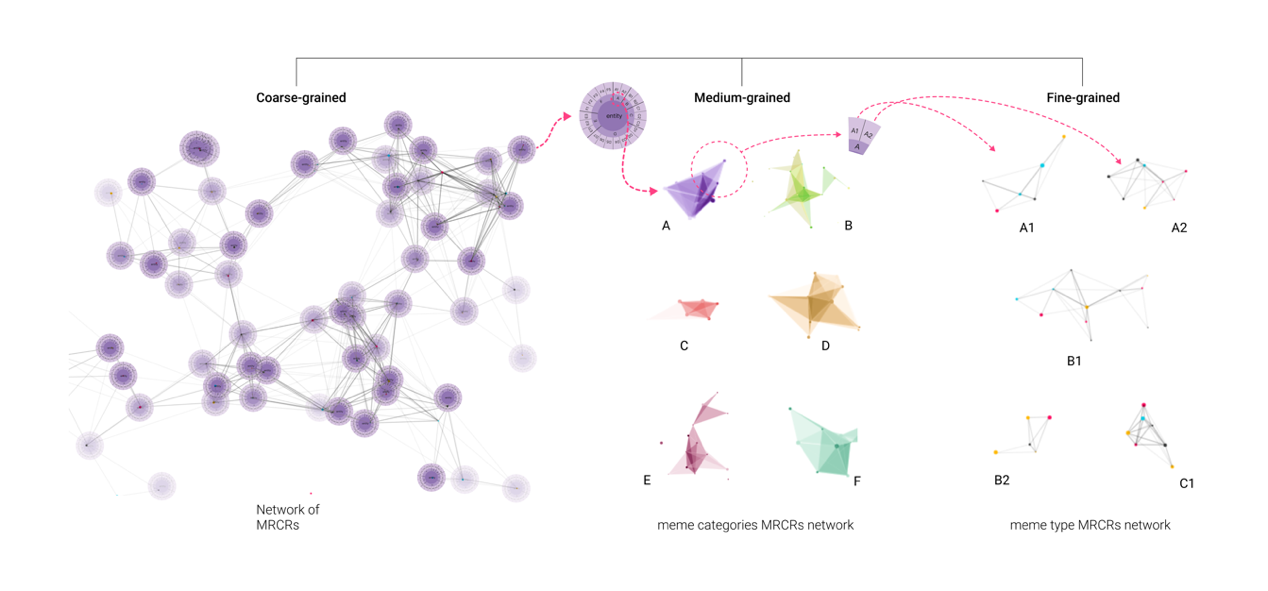1. Introduction
Revolutionary cultural heritage is the witness of historical period as well as the objective carrier and physical basis of Red Culture [1] Different from the artistic and scientific values of traditional cultural heritages, the pivotal characteristic of revolutionary cultural heritage is the unique cultural genetic value given by the special historical context, which is also an important reason to distinguish them from other cultural heritages. In recent years, the development of information technology has driven a transformation in the innovation direction of cultural heritage(including tangible cultural heritage and intangible cultural heritage), shifting from a material level to digital innovation in virtual spaces [2-3]. As a special category of cultural heritage, revolutionary cultural heritage has important reference value in the process of digital cultural innovative design. As a special category of cultural heritage, revolutionary cultural heritage has important reference value in the process of digital cultural innovative design. In addition to the development of extraction and storage technology and the improvement of protection methods, the research should focus on how to promote the transformation and application of cultural heritage characteristics and internal Red Culture in a way that is easily understood by the public, including the digital construction of Red Culture theme exhibition hall and Red Culture electronic database [4-6].
2. Literature review
“Meme” was first raised by Richard Dawkins in “The Selfish Gene” in 1976 and was regarded as the basic unit of cultural inheritance in the research process of cultural evolution, spreading through non-genetic means such as imitation and replication [7]. The term “gene” originated from Darwin's theory of biological evolution and is an internal genetic code that determines the basic structure of an organism, having a mapping relation of control and encipherment with the representative traits of the organism. Memes are considered as genetic analogues with biologically similar genetic structures in some studies, serving as internal abstract genetic information that maps with external physical features. This mapping relation supports the translation between cultural heritage ontological attributes and memes, and establishes a mapping model for memes and ontological attributes, as shown in Figure.1.

Figure 1: Mapping Model for Meme and Ontological Attribute
As biological gene analogues, memes not only conform to the mapping characteristics of genetics, but also meet the consistency characteristics. Like biological genes, if a certain ontological attribute of different revolutionary cultural heritage resource individuals is the same, it indicates that the memes contained within them also have consistency, thus forming a linkage relation. The derivation of meme consistency is shown in Figure.2.

Figure 2: Derivation of Meme Consistency
Knowledge graph is an emerging technology for smart correlation and search proposed by Google in 2012, which describes various entities and their relations in the real world in the form of accurate computer semantics and networked graphics, and improves knowledge retrieval capabilities by structured methods through effective knowledge association and management, thereby achieving the goal of displaying, reusing and inferring relevant domain knowledge information. Among them, the head entity and tail entity come from the knowledge graph entity dataset and are represented by core structural points, and relation is the set of entity relation data, represented by directed line segments.
The digital innovative activation of revolutionary cultural heritages promote the deepening transformation, application and cultural dissemination of resource information. By constructing an innovative activation and application model that coordinates digital technology and creative design, the objective form carried by revolutionary cultural heritages themselves is presented digitally, and targeted extraction for creative design is conducted, realizing the expression and inheritance of memes, and to deeply elaborating on the cultural attributes inherent in them. With the support of digital technology, the creative application of Red Memes through innovative design methods helps drive the output of digital virtual creative design with real resources as the core, thereby increasing the participation of revolutionary cultural heritage data in digital innovative activation and application, inspiring relevant design participants to acquire design inspiration at the beginning of digital creative design, and generating design schemes that are sustainable, novel and aesthetically pleasing.
3. Method
3.1. Entity Extraction of Revolutionary Cultural Heritage
The entity extraction of revolutionary cultural heritage is one of the important steps in constructing a knowledge graph, and the extraction process is based on the semi-structured open-source archives of revolutionary cultural heritage that have already been formed. To extract entities from revolutionary cultural heritage, it is first necessary to use a unified information resource identifier to identify the semi-structured text data of cultural heritage structurally and digitally, ensuring that the entity units have the same semantic structure in the input dataset of structured resource entities, allowing computers to understand and extract shared structured data and key information, thus the semantic transformation of revolutionary cultural heritage, "unstructured, semi-structured, structured" data.
3.2. Relation Extraction Rules for Revolutionary Cultural Heritage Knowledge Graphy
The purpose of the task of extracting relations between revolutionary cultural heritages is to associate entities from multiple heterogeneous data sources through the similarity principle between defined memes, thus establishing the semantic relations between different revolutionary cultural heritage entities. Accordingly, based on the similarity between memes and biological genes, the relation extraction rule of revolutionary cultural heritage that meets the needs is constructed through the relation consistency between memes. The relation extraction of revolutionary cultural heritage knowledge graph not only focuses on the coarse-grained individual relations formed by the consistency of memes (M) under macro conditions, but also needs to fully utilize the granularity structure model of revolutionary cultural heritage to construct a multi-hierarachy relation network, increase the presentation form of relation information at the medium granularity hierarchy, provide logical links between vertical logical hierarchies, and ensure the comprehensiveness of relation construction. According to the entity dataset structure of revolutionary cultural heritage knowledge graph, it can be seen that there is a predefined hierarchical semantic structure with a vertical tree distribution among coarse-grained revolutionary cultural heritage entities, medium grained meme categories, and fine-grained memes. where the larger granularity is the upper node, containing the corresponding lower node semantics, and the larger the granularity level, the more generalized the semantic information contained. On the basis of granularity hierarchy rules and the application requirements of the revolutionary cultural heritage knowledge graph, it is proposed to construct relation connection methods from different granularity hierarchies to supplement the extraction rules, define the final composite relation extraction rules, and provide multi-channel retrieval paths for the subsequent activation and application of revolutionary cultural heritage.
3.3. Meme of Revolutionary Cultural Heritage
The mapping relation between ontological attributes and memes mainly reflects the mutual transformation pattern of resources from entity features to internal genetic codes. The scope of determining the ontological attributes of revolutionary cultural heritage has to meet the needs of digital innovation applications, and the text data of ontological attribute under 102 different information names obtained from the paper archives of cultural heritage collections should be screened. After removing special materials used for research and excluding valualess attributes components of revolutionary cultural heritage, as well as screening out attribute factors that are easy to express in creative design, then the scope of sifting ontological attribute is focused on: (1) emphasizing the objective description of revolutionary cultural heritage in digital innovation, which includes visual elements, tactile elements, imagery elements, etc., and paying attention to the direct participation of resource attributes in creative design; (2) highlighting that the focal point of digital innovation applications returns to the inherent functions of cultural heritage, and mainly focuses on categories, cultural relic functions and information related to usage, exploring digital description methods of traditional behavior patterns; (3) describing the ontological attribute of spiritual characteristics when it comes to revolutionary cultural heritage, including the historical background, cultural connotations, and spiritual value of cultural relics, to enhance the cultural identity of revolutionary cultural heritage in digital innovation. Taking the three aspects above as the basic framework for extracting the ontological attribute of revolutionary cultural heritage, 22 ontological attributes of revolutionary cultural heritage for digital innovative activation and application are identified.
3.4. Meme Category of Revolutionary Cultural Heritage
As for revolutionary cultural heritage, the generalization of its coarse-grained entity and the differentiation of its fine-grained meme can easily lead to a decrease in the applicability and objectivity of the digital structure of revolutionary cultural heritage. Moreover, the single granularity hierarchy of revolutionary cultural heritage entities in the application process limit the evolution path of digital creative design. Therefore, it is necessary to add a hierarchy of medium-grained meme category between fine-grained revolutionary cultural heritage meme and coarse-grained cultural heritage resource entity, forming the progressive connective organization and management hierarchy, in order to support the optimal path for design retrieval and application in the form of multiple structures and channels. The final results are shown in Table.1.
Table 1: Meme Category of Revolutionary Cultural Heritage
Meme Category | Definition | Meme |
A. Date | The meme collection related to time. | A1. Date; A2. Date Type |
B. GEOGRAPHY | The meme collection related to geography. | B1. Region; B2. Region Type |
C. HUMANITIES | The meme collection related to humanity. | C1. Humanities Type; C2. Humanities; C3. Profile |
D. MATERIALITY | The meme collection related to physical characteristics. | D1. Physical Appearance; D2. Texture; D3. Measurement; D4. Volume; D5. Quality; D6. Color; D7. Luster; D8. Quantiy |
F. GENRE | The meme collection related to genre. | F1. Type; F2. Function Type; F3. Facture |
G. LOGOTYPE | The meme collection related to logotype. | G1. Unique Mark; G2. Language; G3. Typeface; G4. Handwriting Color; G5. Inscription Situation |
4. Revolutionary Cultural Heritage Knowledge Graph
The essence of constructing a knowledge graph of revolutionary cultural heritage is to integrate and associate discrete and fragmented resources, forming a composite network that includes individual information, memes, global networks, relation networks, etc., to assist users in developing a comprehensive understanding of resources during digital innovative activation and application design, and provide corresponding design references, retrieval paths and inspiration sources, thus promote the improvement of cultural expression and inheritance efficiency of revolutionary cultural heritages in modern society. Therefore, the construction of revolutionary cultural heritage knowledge graph needs to meet the following principles: (1) take the resource ontology as the structural core, and pay attention to the objectivity and integrity of revolutionary cultural heritage; (2) take memes as the relational basis, reflecting the cultural inheritance characteristics of revolutionary cultural heritage; (3) take flexible application as the organizational task to realize the innovative driving force of revolutionary cultural heritage.
After constructing and building the relation network of revolutionary cultural heritage knowledge graph, it is satisfied to set up a structured dataset for the objective entities and relations in the real world, but further visualization of relation network is still needed. The visualization content needs to meet the following perspectives: (1) the visualization network of knowledge graph can directly display the overall framework of revolutionary cultural heritage, with a focus on the presentation of linear connections among revolutionary cultural heritages; (2) the input of vague keywords for displaying the retrieval results from different granularity hierarchies is supported, and the visualization network of revolutionary cultural heritage associated with project keywords at each hierarchy is acquired; (3) the visualization results of knowledge graphs generated for different purposes of digital innovative activation and application must meet the requirements of form and function, and it is necessary for the visualization results to be provided with the attribute that can design and apply directly. The final visualization result is shown in Figure.3.

Figure 3: Visualization Example of Revolutionary Cultural Heritage Knowledge Graph
5. Digital Cultural Innovative Design Model of Revolutionary Cultural Heritage
As a significant and nonrenewable cultural resource, revolutionary cultural heritage is not only the physical witness of the historical period, but also the inheritance carrier of Red Culture. Through the application of revolutionary cultural heritage knowledge graph in digital cultural innovative design process, an integral network diagram is provided for the design project as design reference, and four periodic design processes are formed: retrieval, reuse, modification and preservation. Designers are supported by digital cultural innovative design model to search the relation network diagram of revolutionary cultural heritages from different hierarchies in course of digital cultural innovative design and derive the ontological attribute mapped by the corresponding Red Meme as the design factor. Then, the design factor is reused, modified and preserved according to requirements of the project, and the design outcome of digital cultural innovation is accomplished eventually. As the structural cluster of exclusive domains, revolutionary cultural heritage knowledge graph is helpful to assist design professionals to get revolutionary cultural heritage information related to the project quickly from the perspective of meme, promote the design outcome to inherit and propagate the spiritual and cultural connotation of the Chinese revolutionary period in a more modern aesthetic way as well as effectively improve the application efficiency of revolutionary cultural heritages in digital cultural innovative design.
6. Conclusion
In the process of digital cultural innovative design, revolutionary cultural heritage, as a pivotal resource, provides an effective information source for designers in the early stage of the project. Nevertheless, designers still face the problem of obtaining and retrieving the information integrity of revolutionary cultural heritage. In order to solve this problem, the method of constructing the conceptual model of revolutionary cultural heritage knowledge graph is raised and applied to design workflow as well as the digital cultural innovative design model of revolutionary cultural heritage is accomplished. Under the guidance of this model, an overall relation network of revolutionary cultural heritage and retrieval paths in different hierarchies can be acquired to provide design reference for digital cultural innovative design projects. Meanwhile, design factors are extracted in accordance with the mapping relation between memes and ontological attributes to increase the stickiness between design outcomes and revolutionary cultural heritages and assist the inheritance and continuation of Red Memes with the means of modern design.
References
[1]. Jia, X. (2018). The concept and definition of revolutionary cultural relics. Journal of Beijing Normal University (Social Sciences), 06, 141-145. doi:10.3969/j.issn.1002-0209.2018.06.015.
[2]. Jiang, A., Cheng, B., Zheng X. & Yao, F. (2020). The application of long-term preservation metadata in the digital protection project of cultural. Digital Library Forum, 06, 2-7. doi:10.3772/j.issn.1673-2286.2020.06.001..
[3]. Liu, Y. (2020). Serving the overall situation opening a new situation exploring a new pattern of digital interconnection for the protection and utilization of cultural relics. People's Tribune, 25, 6-8.
[4]. Kwan, D. H., & Kwan, J. M., (2017). Empowering cultural preservation in China through participatory digitization. Journal of Archaeological Science: Reports, 12, 161–164. doi:10.1016/j.jasrep.2017.01.043.
[5]. Sharma, M. K., & Siddiqui, T. J., (2016). An Ontology Based Framework for Retrieval of Museum Artifacts. Procedia Computer Science, 84, 169-176. doi:10.1016/j.procs.2016.04.083.
[6]. Kiourt, C., Koutsoudis, A., & Pavlidis, G. (2016). DynaMus: A fully dynamic 3D virtual museum framework. Journal of Cultural Heritage, 22, 984-991. doi:10.1016/j.culher. 2016.06.007.
[7]. Dawkins, R. The Extended Selfish Gene, CITIC Press Corporation, Beijing, 1998.
Cite this article
Li,W.;Wang,Z. (2024). Research on the Construction of Revolutionary Cultural Heritage Knowledge Graph and the Application of Digital Cultural Innovation. Communications in Humanities Research,34,93-99.
Data availability
The datasets used and/or analyzed during the current study will be available from the authors upon reasonable request.
Disclaimer/Publisher's Note
The statements, opinions and data contained in all publications are solely those of the individual author(s) and contributor(s) and not of EWA Publishing and/or the editor(s). EWA Publishing and/or the editor(s) disclaim responsibility for any injury to people or property resulting from any ideas, methods, instructions or products referred to in the content.
About volume
Volume title: Proceedings of the 3rd International Conference on Literature, Language, and Culture Development
© 2024 by the author(s). Licensee EWA Publishing, Oxford, UK. This article is an open access article distributed under the terms and
conditions of the Creative Commons Attribution (CC BY) license. Authors who
publish this series agree to the following terms:
1. Authors retain copyright and grant the series right of first publication with the work simultaneously licensed under a Creative Commons
Attribution License that allows others to share the work with an acknowledgment of the work's authorship and initial publication in this
series.
2. Authors are able to enter into separate, additional contractual arrangements for the non-exclusive distribution of the series's published
version of the work (e.g., post it to an institutional repository or publish it in a book), with an acknowledgment of its initial
publication in this series.
3. Authors are permitted and encouraged to post their work online (e.g., in institutional repositories or on their website) prior to and
during the submission process, as it can lead to productive exchanges, as well as earlier and greater citation of published work (See
Open access policy for details).
References
[1]. Jia, X. (2018). The concept and definition of revolutionary cultural relics. Journal of Beijing Normal University (Social Sciences), 06, 141-145. doi:10.3969/j.issn.1002-0209.2018.06.015.
[2]. Jiang, A., Cheng, B., Zheng X. & Yao, F. (2020). The application of long-term preservation metadata in the digital protection project of cultural. Digital Library Forum, 06, 2-7. doi:10.3772/j.issn.1673-2286.2020.06.001..
[3]. Liu, Y. (2020). Serving the overall situation opening a new situation exploring a new pattern of digital interconnection for the protection and utilization of cultural relics. People's Tribune, 25, 6-8.
[4]. Kwan, D. H., & Kwan, J. M., (2017). Empowering cultural preservation in China through participatory digitization. Journal of Archaeological Science: Reports, 12, 161–164. doi:10.1016/j.jasrep.2017.01.043.
[5]. Sharma, M. K., & Siddiqui, T. J., (2016). An Ontology Based Framework for Retrieval of Museum Artifacts. Procedia Computer Science, 84, 169-176. doi:10.1016/j.procs.2016.04.083.
[6]. Kiourt, C., Koutsoudis, A., & Pavlidis, G. (2016). DynaMus: A fully dynamic 3D virtual museum framework. Journal of Cultural Heritage, 22, 984-991. doi:10.1016/j.culher. 2016.06.007.
[7]. Dawkins, R. The Extended Selfish Gene, CITIC Press Corporation, Beijing, 1998.









